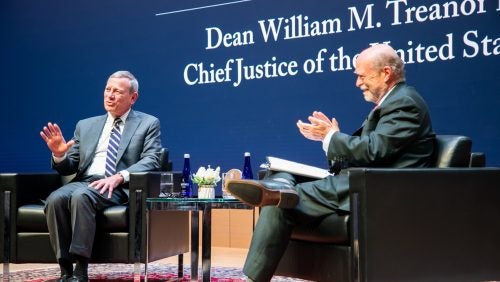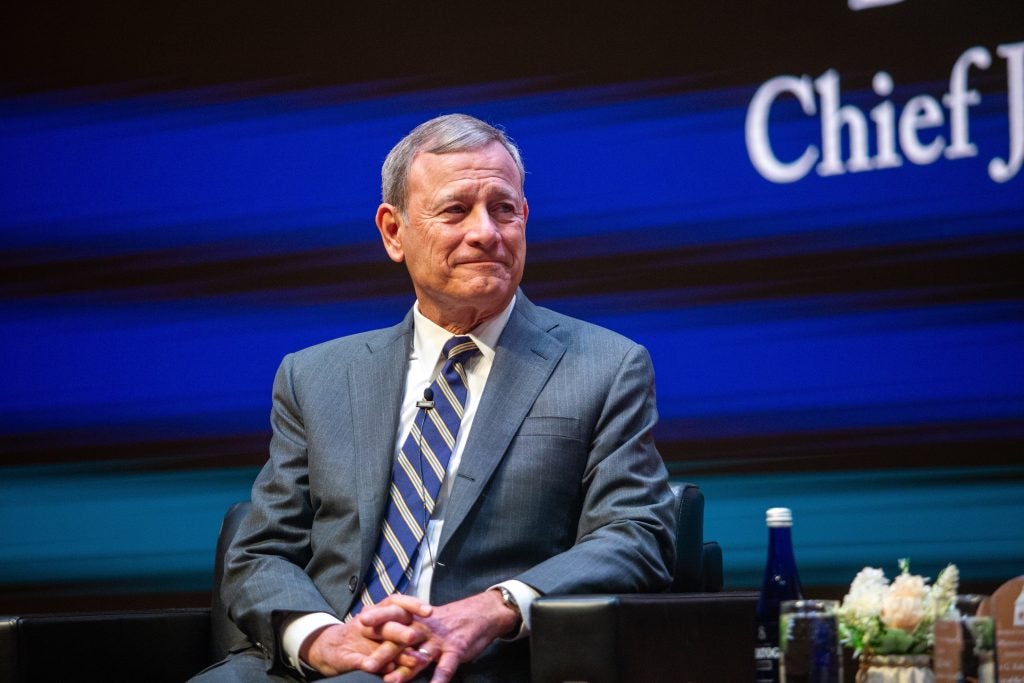A ‘Basic Proposition’: Chief Justice of the United States John G. Roberts, Jr., Reflects on the Rule of Law in Address to Class of 2025
May 15, 2025

Chief Justice of the United States John G. Roberts, Jr., left, joined Dean William M. Treanor in the newly renovated Hart Auditorium.
Chief Justice of the United States John G. Roberts, Jr., visited Georgetown Law on May 12 to deliver the Lecture to the Graduating Class of 2025. The conversation series, held each spring, brings leading legal advocates to campus to offer candid guidance to outgoing Law Center graduates as they embark on their legal careers.
“The notion that rule of law governs is the basic proposition,” Roberts said in conversation with Dean William M. Treanor in response to a question about the role of an independent federal judiciary in upholding the rule of law. “Certainly as a matter of theory, but also as a matter of practice, we need to stop and reflect every now and then how rare that is, certainly rare throughout history, and rare in the world today.”
The Chief Justice, who was nominated by President George W. Bush and assumed office in 2005, underscored the importance of civics education and urged the some 400 students in attendance to consider volunteering to educate younger generations. “One area where [the rule of law] is most endangered is young people,” he said. “We’re developing a situation where a whole group of young people is growing up having no real sense about how our system of justice works.”
Roberts offered advice to new graduates preparing to enter legal practice, emphasizing the importance of listening and humility in approaching legal problems — a skill he likened to the work of a physician making an informed diagnosis. “You don’t want to give a diagnosis right away; you want to figure out what the symptoms are,” he said. “People you are dealing with will be impressed by the fact that you seem to understand that you don’t know everything already.”
An evolving profession

Chief Justice of the United States John G. Roberts, Jr.
Roberts also addressed criticism of the United States Supreme Court and its opinions. “The Court has obviously made mistakes throughout its history, and those should be criticized, so long as it is in terms of the decision, really, and not ad hominem against the Justices,” he said.
“The normal divisions people focus on, whether it is 5-4, most cases are not that,” he said regarding the sense of collegiality that the Justices share. “We are together on cases unanimously more than any other combination.”
Regarding his own approach to legal writing and analysis, the Chief Justice reflected on the formative influence of the judges he served as a law clerk. Roberts clerked for Judge Henry J. Friendly of the United States Court of Appeals for the Second Circuit from 1979-80 and for then-Associate Justice William H. Rehnquist during the U.S. Supreme Court’s 1980 Term. “I feel very lucky not only to have the clerkships but seeing different perspectives and different ways of approaching the job,” he said.
Even seeming career setbacks, he added, can prove fortuitous over time. “If I’d been confirmed at that early age when a vacancy came upon the [Supreme Court], I probably would’ve had too much baggage to be considered for it,” he said regarding his failed nomination to the Court of Appeals for the District of Columbia Circuit in 1992, when he was 37. In 2001, Roberts was again nominated for a seat on the D.C. Circuit and served in that role from 2003 until 2005, when he joined the nation’s highest court as Chief Justice.
Roberts noted that the challenges facing young lawyers today — and the competencies needed to incorporate emergent technologies such as artificial intelligence (AI) into legal practice — have transformed significantly since the start of his own legal career and will continue to change over time.
“The skills to be a good lawyer, they evolve,” he said.
Click here to view a full recording of Chief Justice Roberts’s address, as recorded by C-SPAN.